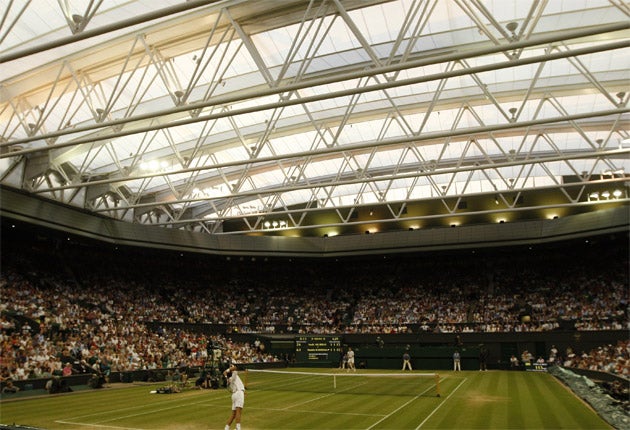Britain's rising star sends expectations through roof
Andy Murray's thrilling win under cover has changed Wimbledon for ever

Wimbledon watchers always knew that the new roof over Centre Court would change the tournament for ever, but until Andy Murray beat Stanislas Wawrinka in a pulsating five-set match here on Monday night few realised quite how dramatic the impact would be.
There could hardly have been a better contest to celebrate the first deployment of the roof – a cliff-hanger involving Britain's best player for three-quarters of a century – and the television viewing figures were remarkable. The average audience was 7.7 million, just 600,000 short of the figure for the recent Champions League final between Manchester United and Barcelona, and peaked at 11.8 million.
The All England Club was understandably delighted. "The standard of tennis was fantastic," Ian Ritchie, the chief executive, said yesterday. "It produced a fantastic event for people here and for millions on television. From where I'm sitting it was a great success."
Although the recent test event, featuring a gentle afternoon's matches involving Andre Agassi, Steffi Graf, Tim Henman and Kim Clijsters, proved that the air management system could keep the court playable under a closed roof, it would have been all but impossible to create in advance the crowd noise as the tension mounted in Monday's final set.
Murray in particular relished the atmosphere, though there were other aspects of the experience that had concerned him. The Scot felt that the roof had increased the humidity. "When I finished it was like I'd been in a bath," he said.
The Scot felt the humidity had affected the match. He said that the balls felt heavier and that it was harder to put away winning shots, which led to longer rallies.
However, the All England Club studied the statistics from its engineering team yesterday and concluded that the roof had actually made the conditions more player-friendly. The average relative humidity during the match was 50 per cent, which was exactly the target level. Outside the court the humidity was between 58 and 59 per cent. By the time the roof was reopened at 10.45pm it had climbed to 60 per cent.
The average temperature inside the court was around 24 to 25C, while the temperature outside was 26C. Although 24C is regarded as the optimum, the purpose of the air management system is to control the humidity – condensation would have a major detrimental effect on the playing surface – rather than the temperature.
Murray was also unhappy at being given little notice that the match would be played under cover. The roof had been deployed during the previous match, between Amélie Mauresmo and Dinara Safina, and a decision was made to keep it closed after a weather forecast, issued at 6pm, showed that there was a 70 per cent chance of more rain, although it never materialised. Murray's match started at 6.41pm.
As it turned out, the roof would have been deployed anyway because of the late finish. Additional electric lighting is used whenever the roof is drawn across and if a match is unfinished by nightfall the cover will be employed to enable it to be completed. This process takes a total of 40 minutes, mostly to create the right atmospheric conditions.
Given that Murray's match did not end until 10.38pm, the finish would have been much later had the players had to leave the court to wait for the roof to be deployed. Ritchie pointed out that the only other alternative – and until this year this would have been the only option – would have been to halt the match and tell the players to come back the next day.
"Deciding to leave the roof closed gave the players a constancy of conditions, without the interruption of the roof closing," Ritchie said. "If it had been two sets to one or two sets all and we had stopped for half an hour to close the roof, it could have transformed the match. This way, they continued all the way through."
Before the tournament the All England Club had always insisted that Wimbledon would remain an outdoor, daytime event whenever possible. The decision to start Murray's match under the roof seemed to run against that thinking, but Ritchie insisted: "We are certainly not going to schedule a regular evening session. The view would still be to keep the roof open as long as we can.
"As an event, it was unbelievable. If we had the same circumstances again, we would do it like that. Would we have done anything differently last night? Absolutely not. What happened was a great event. It may not happen again this week and it could happen tomorrow. I don't think it will, but I don't see any negatives at all."
Attracting viewers: How Murray stacks up in TV ratings fight
11.8 million
The peak number of viewers who tuned in to watch Murray take on Wawrinka on BBC1, only 500,000 less than last year's men's final.
14.6 million
Peak number of viewers who saw Manchester United beat Chelsea in the 2008 Champions League final.
17 million
Average number of viewers who watched the Rugby World Cup final, South Africa v England in 2007.
9.8 million
Peak figure for the final of The Apprentice on BBC One last month.
20.5 million
Peak number of viewers who tuned in to Eastenders to find out who shot Phil Mitchell in 2001.
Cover up: Roof facts
177 metres the span of the moving roof trusses.
13,000 tonnes the total weight of the new roof.
17,500 the number of umbrellas it would take to cover the same area as the roof.
1995 the last year that there was a rain-free Wimbledon fortnight.
Join our commenting forum
Join thought-provoking conversations, follow other Independent readers and see their replies
Comments